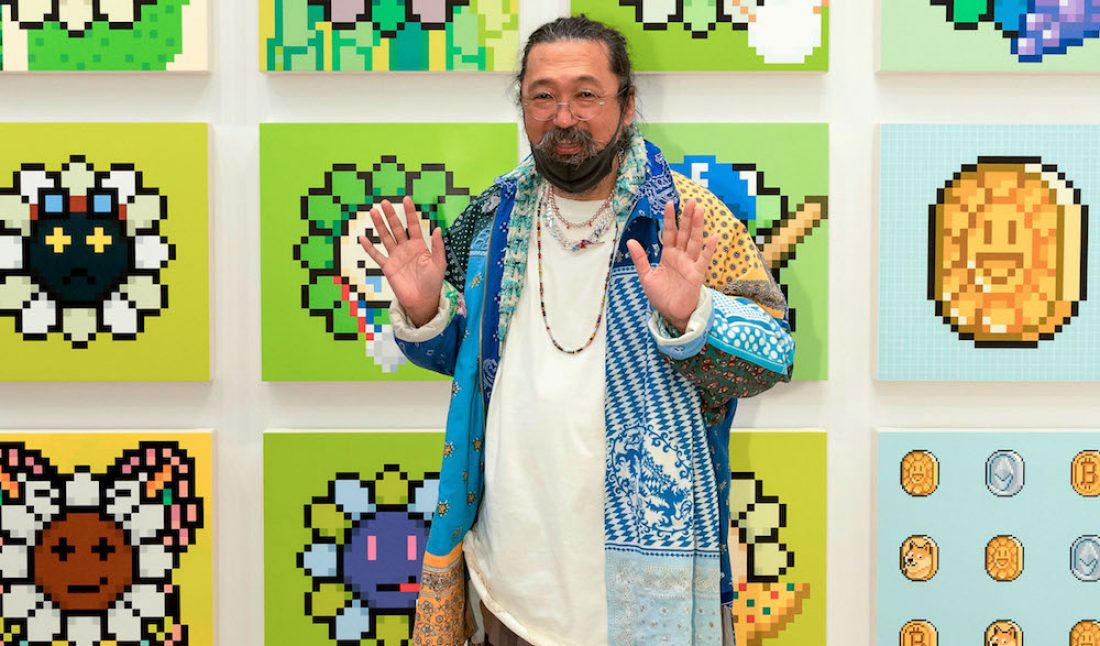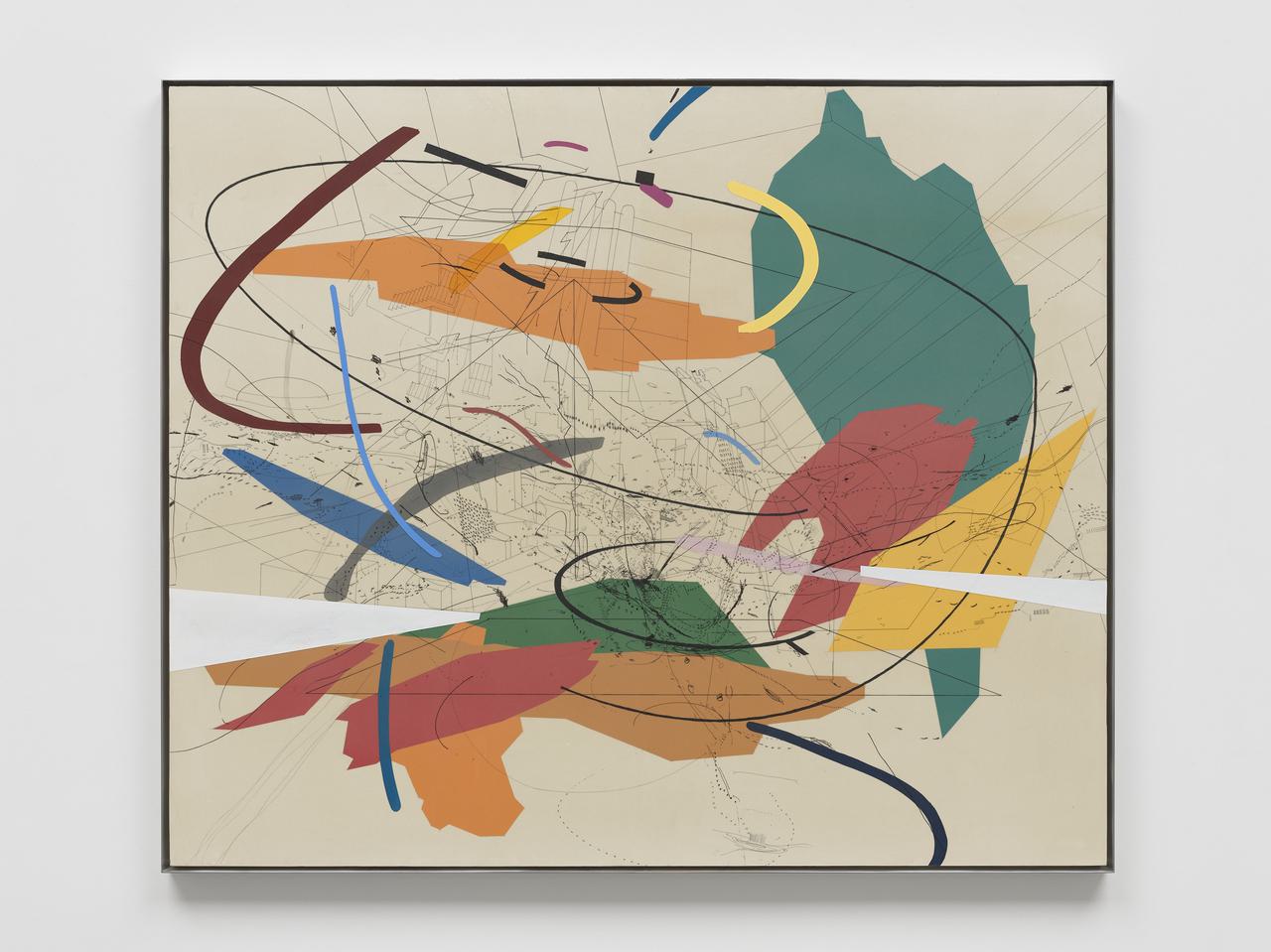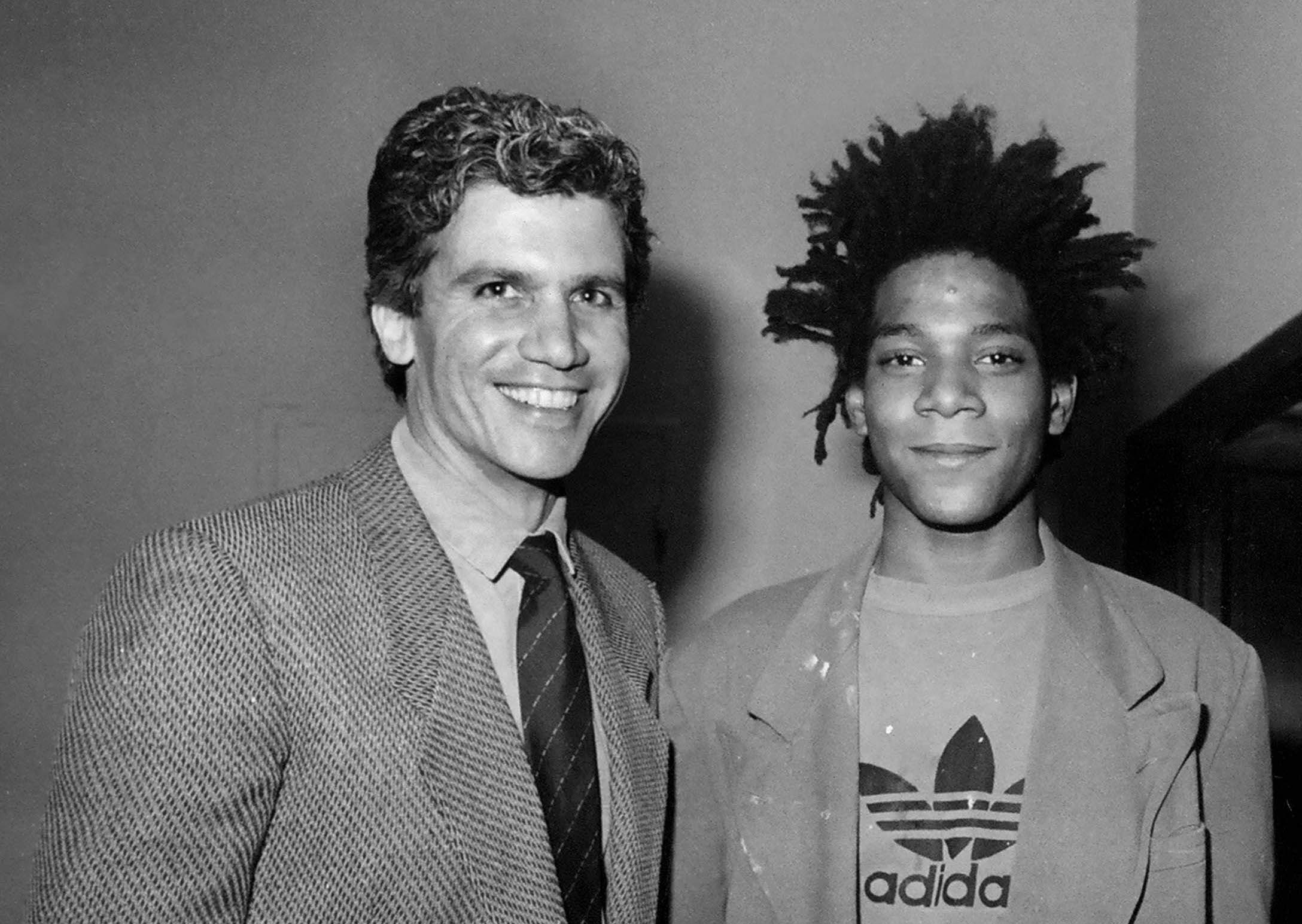Takashi Murakami’s prolific body of paintings, sculptures, installations, digital projects, and collaborations is infused with a deep sensibility for the world we have inherited and inhabit today. Responding to societal, cultural, and environmental changes, he references the language of Japanese anime alongside centuries-old image-making, combining old and new, learned and innate, history and imagination. His current shows “Takashi Murakami: Stepping on the Tail of a Rainbow” (May 21–September 25) at The Broad in Los Angeles and “An Arrow through History” (May 11–June 25) at Gagosian in New York exemplify those aspects of his practice rooted in tradition, religion, globalization, disaster, and pop culture.
For Murakami’s first solo show at The Broad, his 82-foot-long painting In the Land of the Dead, Stepping on the Tail of a Rainbow [2014] takes center stage. Surrounding it are several new pieces, 18 paintings from the museum’s private collection, and a new AR experience. In partnership with Meta’s Spark AR, BUCK, and Instagram, Murakami’s digital environments express the complex subject matter of the works on view.
“Murakami is brilliant at interpreting global upheavals and the energies that flow from them. He started in the wake of World War II, exploring phenomena like anime and manga and setting them in relationship to older Japanese art traditions,” said Ed Schad, curator and publications manager at The Broad. “He undertook a similar strategy in the wake of the 2011 earthquake, tsunami, and nuclear disaster using Buddhist traditions of Arhats and Daoist Immortals. In the midst of COVID-19, we return to these threads in Murakami’s career through classic works, as well as newer directions in both physical and digital worlds.”
At Gagosian in New York is a three-part presentation inspired by an ancient Yuan dynasty vase and the artist’s recent foray into NFTs. Featured are fish-motif paintings, pixelated interpretations of his “Murakami.Flowers” NFT motifs, flowers, and hand-painted portraits and full-scale figurative sculptures based on his “Clone X” digital avatars. There’s an AR element as well, this time in partnership with Snapchat Lenses to digitally activate the space with a variety of animations.
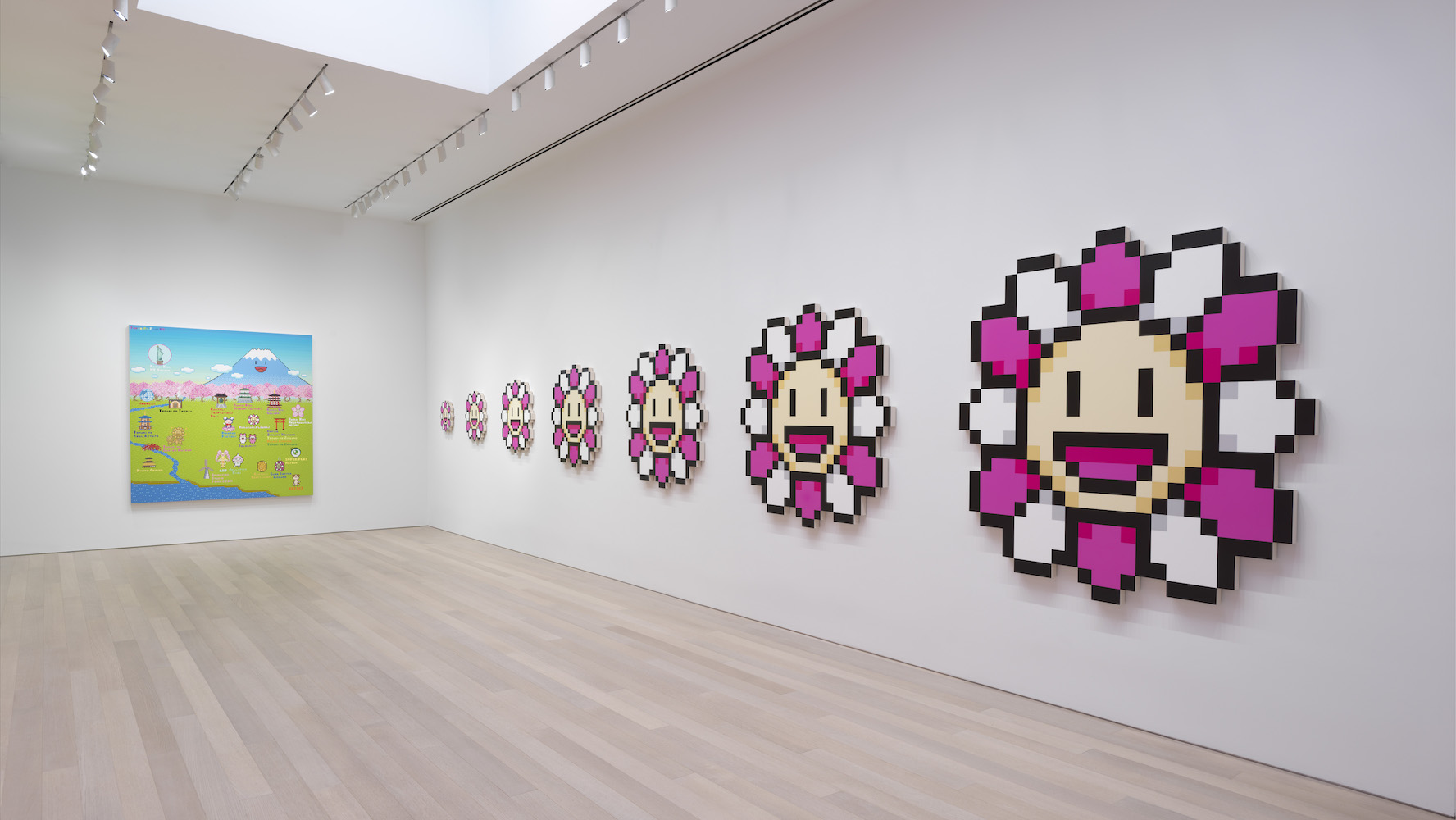 Installation view of Takashi Murakami’s “An Arrow Through History,” at Gagosian, New York (May 11–June 25), photo by Rob McKeever, © 2022 Takashi Murakami/Kaikai Kiki Co., Ltd. courtesy of the artist and Gagosian.
Installation view of Takashi Murakami’s “An Arrow Through History,” at Gagosian, New York (May 11–June 25), photo by Rob McKeever, © 2022 Takashi Murakami/Kaikai Kiki Co., Ltd. courtesy of the artist and Gagosian.
Whitewall spoke with Murakami about creating work in both physical and digital realms, how he balances traditional Japanese techniques with new-age technologies, and what he’s working on next.
WHITEWALL: Your show at The Broad explores topics related to globalization and humankind. How are you personally thinking about those topics now, amid changes brought on by crises like the global pandemic and the war in Ukraine?
TAKASHI MURAKAMI: Right before the onset of the pandemic, I read Yuval Noah Harari’s Sapiens: A Brief History of Humankind [2011]. His view that humankind has become the most powerful species on earth by constructing narratives and fiction, that religions and nations are also narrative constructs, made sense to me.
Once the pandemic began and the fear of death became increasingly prevalent, people’s interests in the future of space exploration and sympathy for Elon Musk’s rocket business accelerated, and the worldview of decentralized blockchain and the shift toward metaverse rapidly grew realistic.
I wonder if Russia’s war in Ukraine may be a battle between the narrative of how an old-world, centralized state should be in the present world versus the narrative of how the future shall be. I also think one of the triggers must have been the major, ubiquitous unrest caused by the pandemic, a natural disaster.
I was compelled to paint the works at the center of the exhibition, In the Land of the Dead, Stepping on the Tail of a Rainbow [2014], and 100 Arhats [2014], after I was faced with the threat of nature when tens of thousands of people died in an instant during the Great East Japan Earthquake and Tsunami on March 11, 2011. Through that experience, I understood in my bones the necessity of religious narrative construction. In Japan, most of us are not monotheistic and we have instead believed in myriad gods, and I now understood that those gods were the natural disasters of tremendous scales themselves.
From there, I started producing films and animations in addition to contemporary art, creating necessary narratives for them, and, in turn, started to work stories into my paintings as well. I was creating new works under the theme that the most important thing for humans to do in the face of a threat was to relieve our brain of its stress.
The examination of the relationship between story and art, which I awoke to back then, is still very much alive in my newest project with NFT.
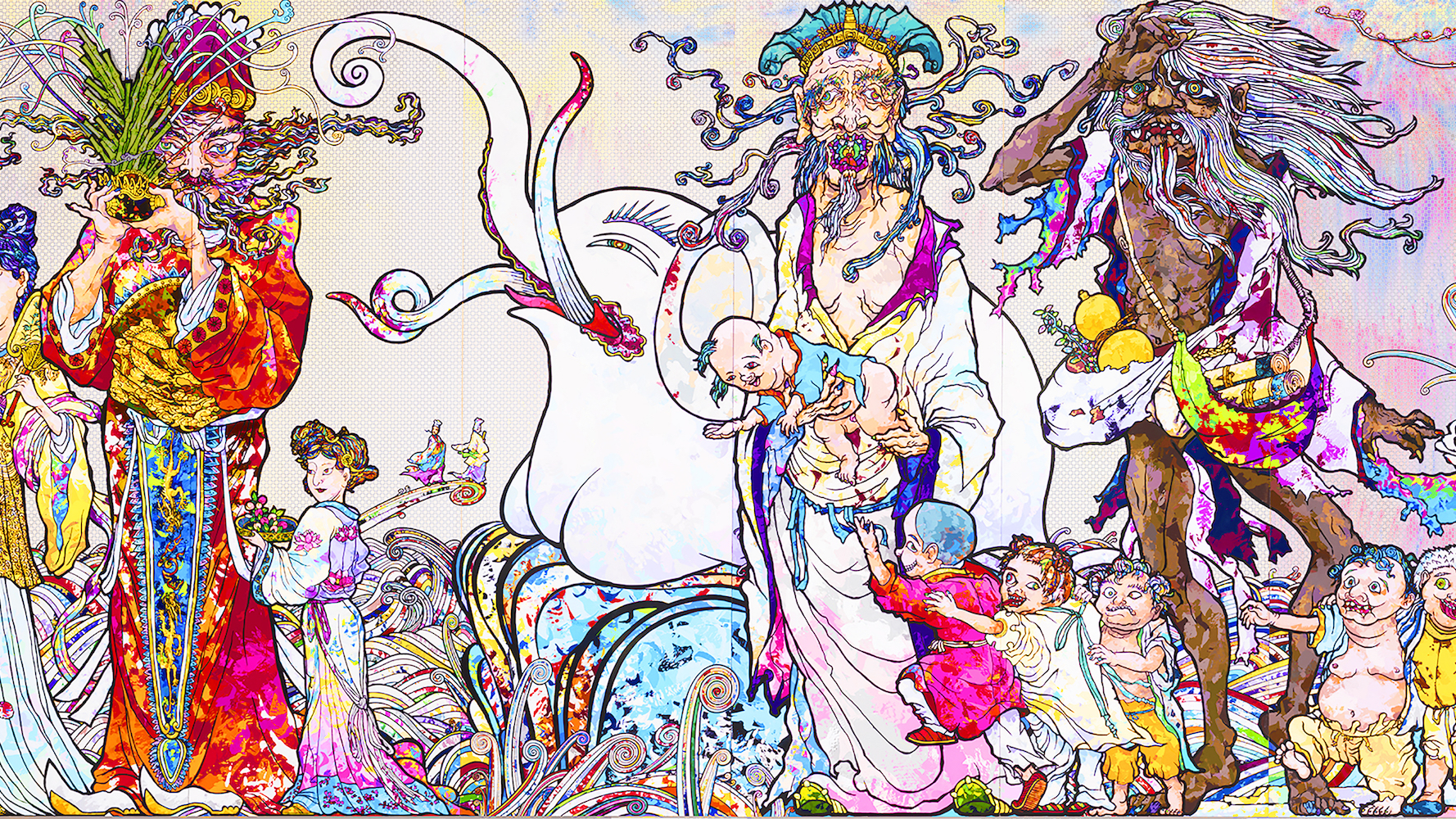 Takashi Murakami, “In the Land of the Dead, Stepping on the Tail of a Rainbow” (detail), 2014, acrylic on canvas, 118 1/8 x 984 1/4 x 2 7/8 in. (300 x 2500 x 7.3 cm), The Broad Art Foundation, © 2014 Takashi Murakami / Kaikai Kiki Co., Ltd. All Rights Reserved.
Takashi Murakami, “In the Land of the Dead, Stepping on the Tail of a Rainbow” (detail), 2014, acrylic on canvas, 118 1/8 x 984 1/4 x 2 7/8 in. (300 x 2500 x 7.3 cm), The Broad Art Foundation, © 2014 Takashi Murakami / Kaikai Kiki Co., Ltd. All Rights Reserved.
WW: How was In the Land of the Dead, Stepping on the Tail of a Rainbow informed by works by the 18th-century painter Soga Shohaku and his exploration of Daoist Immortals?
TM: The immortals, as a subject, originated in Chinese literati paintings. In Japan, Soga Shohaku deconstructed it, creating a masterpiece in which he depicted the grotesque characters with meticulous, realistic details. Seeing his work, I, in turn, deconstructed it according to the operating system of contemporary art—that is, the rule and mechanism of building bridges with an awareness of the cultural divide and inducing understanding. The gist of this work, then, is the structure of lost in translation.
At the same time, it is one of the works for which I did my absolute best in my life. An athlete—say, a soccer player—would have a handful of best, fantastic plays in their careers; if I may say so myself, this work is one of them for me.
WW: You recently stepped into the digital world, creating your first NFTs “Murakami.Flowers” and “Clone X.” Why?
TM: I awoke to the metaverse in the summer of 2020, the first year of the pandemic, when I saw how my children interacted with “Animal Crossing: New Horizons.” They were watching a firework display in the game with their school friends over Zoom, and when it was over, they admiringly discussed how beautiful it was. I saw the reality of the shifting values when I realized that these children could discern beauty within a small videogame screen.
This experience was like the one I had when I first encountered contemporary art at the age of 26, when I was shocked by how there was always a gap between what you saw and the concept and realized that once I understood the context behind the gap, the artworks took on entirely different appearances. I shuddered with a sensation that made me want to roar in excitement.
So, I simplistically decided to make a game, and thinking it shouldn’t be too hard to make one in the style and level of Tamagotchi, I searched for a developer. That’s how I met Yoshihisa Hashimoto, a game producer.
One day, Hashimoto-san said during our development meeting, “Have you seen the craziness surrounding an NFT art at an auction?” and gushed enthusiastically about Beeple’s auction result and related news. He mentioned CryptoPunks, CryptoCats, and yes, about RTFKT as well, saying, “They are making AR sneakers! Doesn’t that have some relevance to the kind of things you did with ComplexCon?”
He somberly went back to the subject of our Tamagotchi-style game, but about six months or so later, RTFKT reached out to me for some reason, proposing to collaborate with me. I was totally taken by surprise. The tone of their message was so frank and carefree—typical of energetic, young people—so I thought it could be a lot of fun and decided to join them.
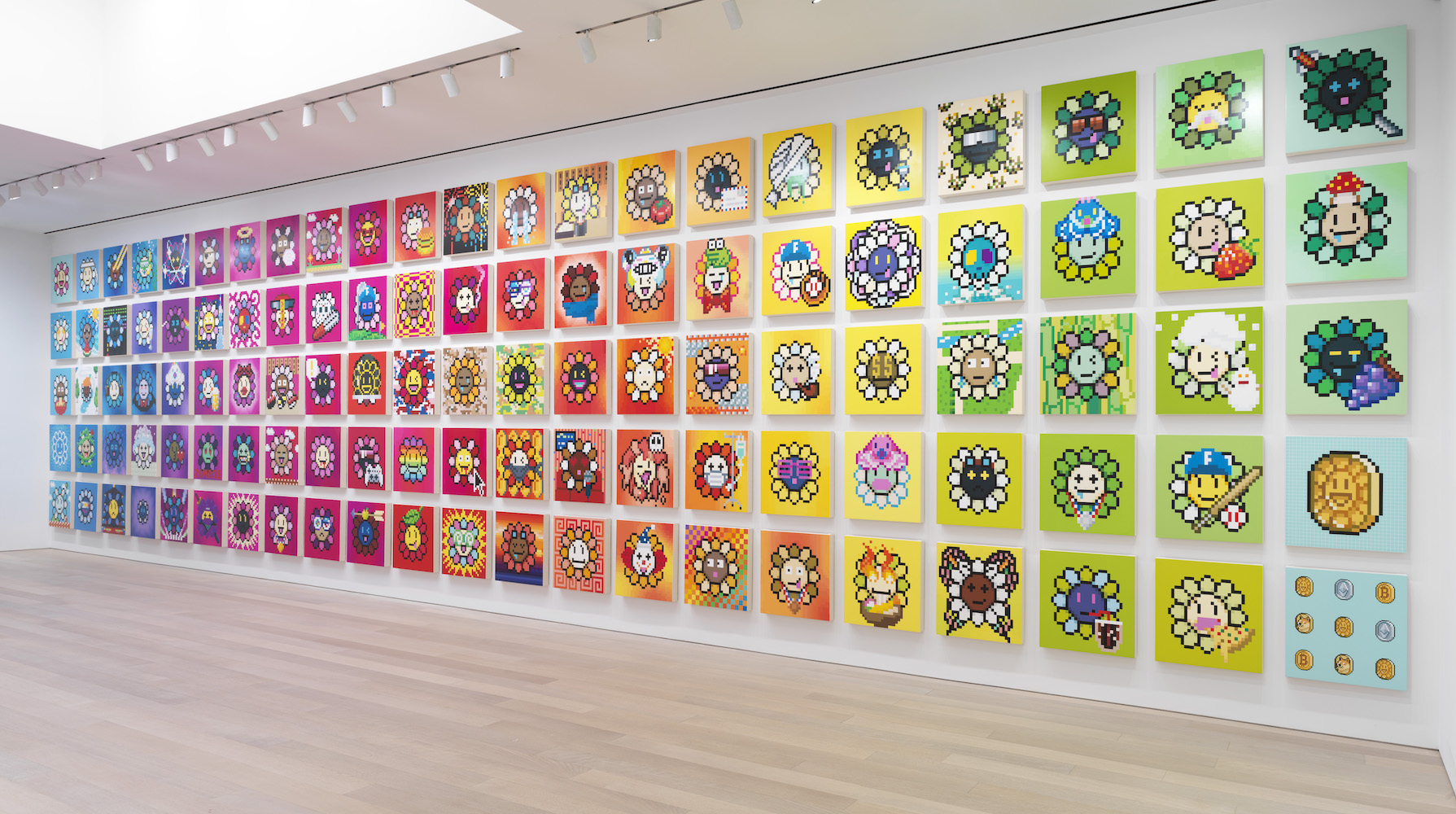 Installation view of Takashi Murakami’s “An Arrow Through History,” at Gagosian, New York (May 11–June 25), photo by Rob McKeever, © 2022 Takashi Murakami/Kaikai Kiki Co., Ltd. courtesy of the artist and Gagosian.
Installation view of Takashi Murakami’s “An Arrow Through History,” at Gagosian, New York (May 11–June 25), photo by Rob McKeever, © 2022 Takashi Murakami/Kaikai Kiki Co., Ltd. courtesy of the artist and Gagosian.
WW: What was the creative process behind making these works?
TM: It all started with the major incident in the art market in the spring of 2021, when Beeple’s work was sold for $69 million at Christie’s. I started looking into NFT art, observing, and learning about the NFT industry’s trends, including CryptoPunks being at the top of the lineup and then Bored Ape Yacht Club subsequently coming along. At the same time, to start learning about cryptocurrency, I set aside some budget and started purchasing some Bitcoin and Ethereum with Japanese yen.
The process of currency exchange let me feel as though I was visiting another country and was very thrilling. But then I hit the wall of Japan’s powerful, negative authority against cryptocurrency and learned that the Web3 idea is still seen as antagonistic to the state. And so I came to think that art within the decentralized Web3 perception—the basis of the concept of virtual currency—is NFT art.
Basically, I studied several role models to understand this concept and to figure out how best to activate my thinking in that context. I created “Murakami.Flowers” by following what I learned and combining my flower character with the context of 1970s videogames—the context like that of CryptoPunks.
After I started researching in March of 2021, I managed to understand the basics by June, but it took about half a year to build a team to generate my NFTs, another half a year to create all the images. After a full year, we finally managed to do the reveal on May 3, 2022.
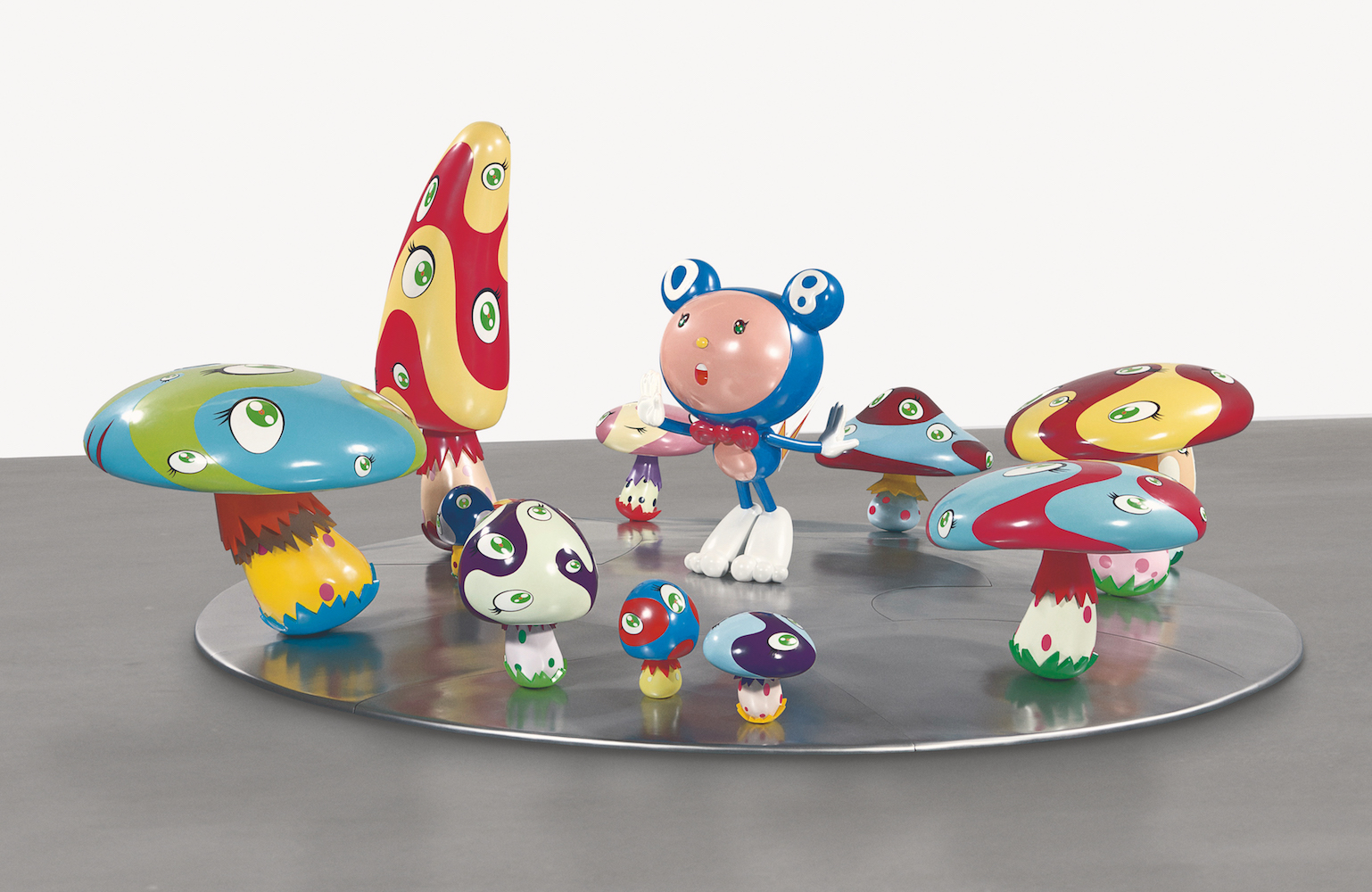 Takashi Murakami, “DOB in the Strange Forest (Blue DOB),” 1999, fiber-reinforced plastic, resin, fiberglass, acrylic and iron, 60 x 152 x 137 in. (152.4 x 386.08 x 347.98 cm), The Broad Art Foundation, © 1999 Takashi Murakami / Kaikai Kiki Co., Ltd. All Rights Reserved.
Takashi Murakami, “DOB in the Strange Forest (Blue DOB),” 1999, fiber-reinforced plastic, resin, fiberglass, acrylic and iron, 60 x 152 x 137 in. (152.4 x 386.08 x 347.98 cm), The Broad Art Foundation, © 1999 Takashi Murakami / Kaikai Kiki Co., Ltd. All Rights Reserved.
WW: How are you thinking about your practice in relation to the metaverse moving forward?
TM: There was a concept of globalism and, from late 1990 through the 2010s, people all around the world moved around using public transportation. Free economics-based interactions between nations grew very active. But since the pandemic, the borderlines defining states are once again being emphasized, and the tensions between nations have increased to the point that war is now breaking out.
Yet humankind, having learned to transcend national boundaries, cannot go back. I think people contemplated how to escape the situation where national borders have been redefined, and one answer was the metaverse space.
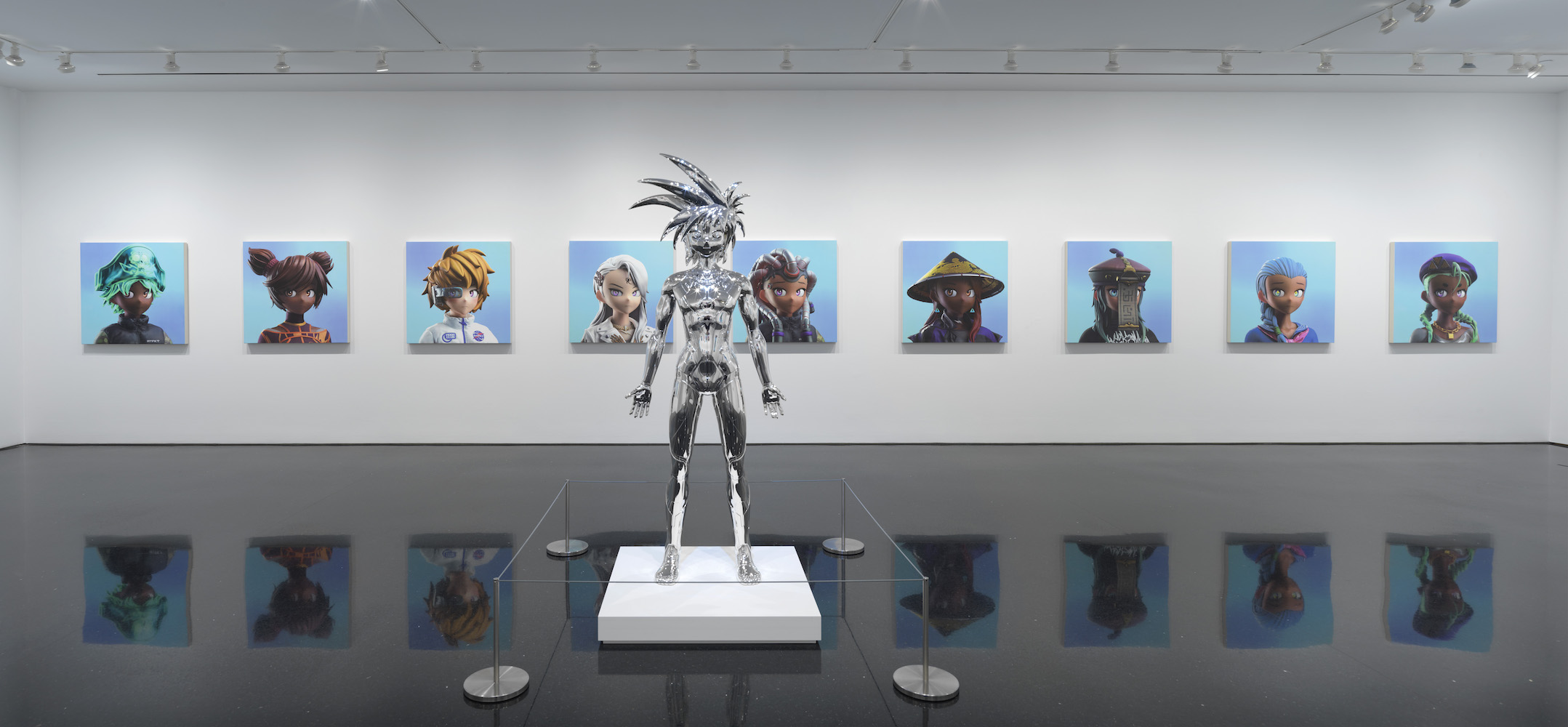 Installation view of Takashi Murakami’s “An Arrow Through History,” at Gagosian, New York (May 11–June 25), photo by Rob McKeever, © 2022 Takashi Murakami/Kaikai Kiki Co., Ltd. courtesy of the artist and Gagosian.
Installation view of Takashi Murakami’s “An Arrow Through History,” at Gagosian, New York (May 11–June 25), photo by Rob McKeever, © 2022 Takashi Murakami/Kaikai Kiki Co., Ltd. courtesy of the artist and Gagosian.
WW: Your spring show at Gagosian, “An Arrow through History,” is a three-part presentation of paintings and sculptures inspired by an ancient Yuan dynasty vase and your own NFTs. Why these two starting points?
TM: The jar in question is a large Yuan dynasty Qinghua jar in the collection of the Museum of Oriental Ceramics, Osaka, with fish and waterweed depicted on it, and I really love this design. When my first exhibition at Gagosian was confirmed, I presented the image to Larry [Gagosian] and said I intended to make paintings based on it. Larry said, “Great, love to see them soon,” and I said, “Okay!” But I couldn’t deconstruct it successfully for a long time. After 15 years, at my 2019 show in Gagosian Beverly Hills, I was finally able to create a satisfactory work. It was quite a relief for me that I managed to fulfill my promise to Larry in his lifetime. The painting I made on that occasion was a huge one, about 18 meters long, and for the current show, the first request Larry had was to make fish paintings on a much more compact scale.
Many people have copied the Yuan dynasty Qinghua motif for honkadori (a term used in traditional Japanese poetry for the emulation of, or borrowing from, existing works), but the superior among them was Rosanjin, the Japanese ceramicist I revere. By further copying the Qinghua fish Rosanjin painted, I managed to possess the painter who painted the original fish on the ancient jar.
Most of these fish paintings are based on historical paintings, but the catfish one alone is a complete original—I thought I could freely paint something in the style of a historical work. I’m quite pleased by how this one turned out.
As for shooting an arrow through history, I contemplated how I might unify my thoughts about art from Yuan dynasty China all the way through to NFT art at the frontline of contemporary art—my own interpretations of NFT and metaverse—and created the “Murakami.Flowers” series of paintings as an embodiment of my answer. So, by having all these works together, I thought I could present something that can spear through the geopolitical transition or various periods in the history of art. Given the chance to do so at the forefront of contemporary art in New York, I truly devoted all I had to create this exhibition. I am also showing my “Clone X” collaboration with the RTFKT team, so I am truly grateful and happy about this project.
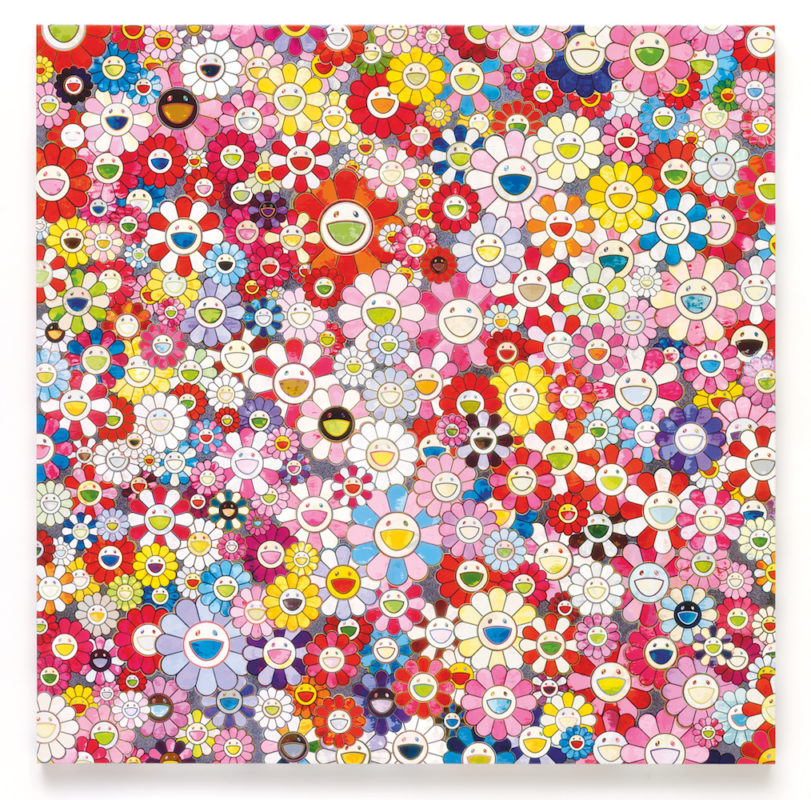 Takashi Murakami, “Shangri-La Pink,” 2012, Marciano Art Foundation, © 2012 Takashi Murakami/Kaikai Kiki Co., Ltd., courtesy of the artist and The Broad Museum.
Takashi Murakami, “Shangri-La Pink,” 2012, Marciano Art Foundation, © 2012 Takashi Murakami/Kaikai Kiki Co., Ltd., courtesy of the artist and The Broad Museum.
WW: The show bridges your work in digital and physical realities and will be augmented by experiential virtual components. What’s experienced here?
TM: RTFKT, who created “Clone X,” has been very positively involved in planning this exhibition, and they are creating the AR elements for the show, as well as the virtual version of the gallery. Honestly, I’m basically looking on from the sideline.
On the other hand, at The Broad, I am leading the efforts to produce the AR. I hope the visitors will enjoy the AR elements at both venues.
WW: Where do you see the future of the metaverse being?
TM: The metaverse is a forbidden fruit. Once you’ve touched it, you cannot go back to the time before you did. I think this experience of cognitive expansion may be similar to the excitement of discovering a new continent. I think for the next few years, this movement will keep exploding, and then in ten years, after it stabilizes, we’ll be jumping up again onto the next new world.
WW: What are you working on next?
TM: This exhibition will provide guidance for the next five years for me, so I plan to go on and create works according to that.
We are in the process of preparing for a solo show of my work in Space Lee Ufan at the Busan Museum of Art in Korea this September. This show will include some of my very early works from when I was a student and didn’t even know what I was doing—works that haven’t been shown so much in the U.S., works from before I started making works on the operating system of American contemporary art. It will be a strange show.
Next year, I have a show at a museum in San Francisco, as well as NFT projects and private gallery shows. There’s a lot coming up. I don’t know how many years I have left to live, but I hope to run all the way through to the end.
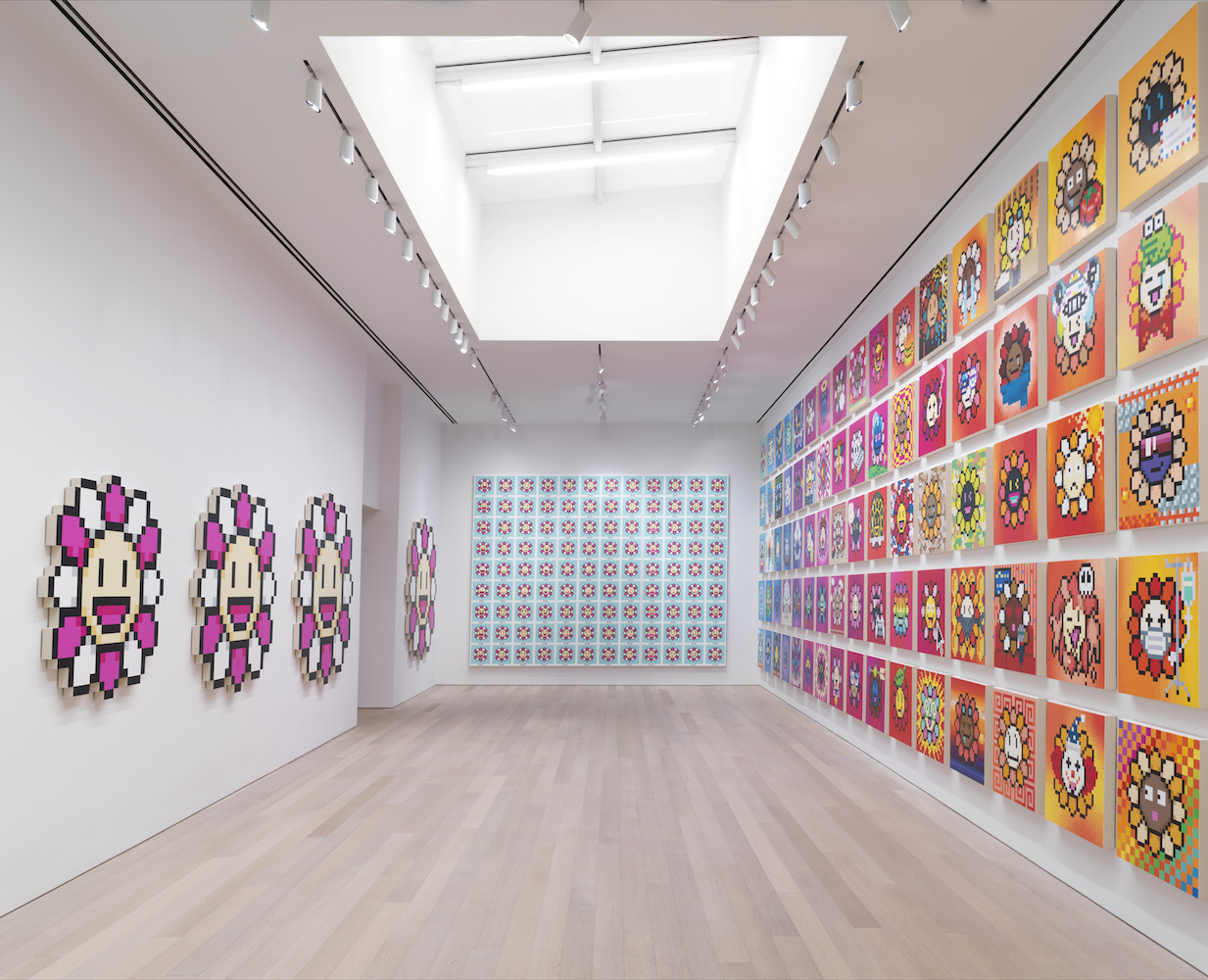 Installation view of Takashi Murakami’s “An Arrow Through History,” at Gagosian, New York (May 11–June 25), photo by Rob McKeever, © 2022 Takashi Murakami/Kaikai Kiki Co., Ltd. courtesy of the artist and Gagosian.
Installation view of Takashi Murakami’s “An Arrow Through History,” at Gagosian, New York (May 11–June 25), photo by Rob McKeever, © 2022 Takashi Murakami/Kaikai Kiki Co., Ltd. courtesy of the artist and Gagosian.







